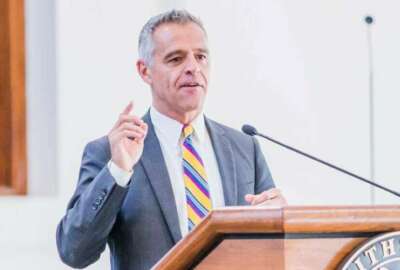By Meg Beasley
Federal News Radio
We may have seen movies like “The Day After Tomorrow” with cataclysmic solar events and extreme weather, but Dr. Richard Fischer lives them. Or, more precisely, in models of them.
Dr. Fischer is Director of the Heliophysics Division within NASA‘s Science Mission Directorate. He is responsible for NASA’s investigation of the Sun.
His research includes observing solar weather and discovering the physics that cause them. There are three types of solar storms: coronal mass ejections, solar flares, and solar particle events. Fischer says they are all caused by “the sun’s trick of converting magnetic energy into motion, heat and light. It does it very suddenly, kind of like a lightning bolt.”
The conversions vary in size and frequency from small events that happen several times a day to larger events that happen in long cycles.
Fischer likens his research to hurricane monitoring. NASA develops data, theories, and models to increase awareness and give other agencies the tools they need to take operational precautions.
When they are large enough, the events can affect earth infrastructure systems. Fischer says flares can disrupt satellites, cause changes in the ionosphere that interrupt communication and navigation, and, rarely, induce a current on the earth that can feed back into our generators and cause them to burn out.
So should we be concerned about the impacts of solar weather? Fischer says that while there is no way we can know with certainty, “there are people in the government, FEMA, who are considering whether this is the kind of event that is low probability but high impact… the best answer I have is ‘maybe’.”
Fischer is quick to point out, though, that these events are not new. Solar weather was first observed around the time of the Civil War when we began to use the telegraph, because the sun’s magnetic currents interrupted the telegraph signals. As our technology and infrastructure become increasingly digital, we increase our sensitivity to solar action.
While ships sailing off coasts and planes flying around the poles are alerted to minor events on a regular basis, most of us will only notice the effects of large cycles in solar weather.
According to Fischer, last year marked a solar minimum with minimal magnetic activity on the sun. Activity will likely “increase and peak in 2013, at which point we should begin to look for big events.”
These events, though noticeable, are not likely to be as dire as Hollywood would have us imagine. Fischer says perhaps the most obvious impact for many will be disruptions to their GPS devices, skewing them by about 300 meters at most. “I think you can still get to your dentist,” he says.
(Copyright 2010 by FederalNewsRadio.com. All Rights Reserved.)
Copyright
© 2024 Federal News Network. All rights reserved. This website is not intended for users located within the European Economic Area.




